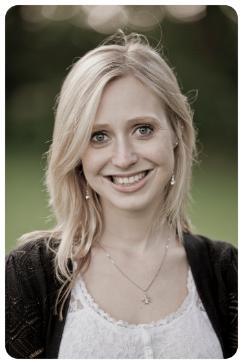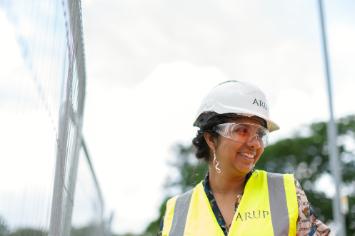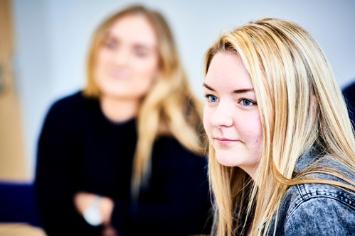Academic Staff from Maths, Stats & Physics
Kate Henderson
Lecturer and Transition Officer
Cora Uhlemann
Lecturer in Applied Mathematics
Sarah Rees
Professor of Pure Mathematics
Sarah Heaps
Senior Lecturer in Statistics
 My name is Sarah Heaps and I’m a Lecturer in Statistics at Newcastle University. Maths was always my favourite subject at school. One of my earliest memories as a child is my mum testing my older brother on his mental arithmetic. I would eavesdrop from outside the room, trying to shout out the answers before he could work them out. Whilst my brother excelled in history and biology, maths was always the subject that came most naturally to me. I think I most enjoyed the modular learning process and the attainability of a perfect solution. As a result, by the time I got to Sixth Form, I had already decided I wanted to study maths at university. After taking A-Levels in Maths, Further Maths, Economics and Chemistry, I did just that.
My name is Sarah Heaps and I’m a Lecturer in Statistics at Newcastle University. Maths was always my favourite subject at school. One of my earliest memories as a child is my mum testing my older brother on his mental arithmetic. I would eavesdrop from outside the room, trying to shout out the answers before he could work them out. Whilst my brother excelled in history and biology, maths was always the subject that came most naturally to me. I think I most enjoyed the modular learning process and the attainability of a perfect solution. As a result, by the time I got to Sixth Form, I had already decided I wanted to study maths at university. After taking A-Levels in Maths, Further Maths, Economics and Chemistry, I did just that.
At school, I was generally amongst the best in my class. However, most of my class did not enjoy maths, so I was worried that when I got to university, I would be a small fish in a big pond of mathematical whizzes. I have always been a competitive athlete, putting in long hours at the gym or pool, and I was very concerned that I would not have time to keep this up once I moved away from home, with my live-in cook, cleaner, laundry and taxi services (aka my parents). However, all my concerns turned out to be misplaced. Hard work was still rewarded with good grades and life as a student was flexible, allowing me to work around my training, whilst learning all those life skills I had practised so little whilst still at school.
Most degrees in the mathematical sciences, including ours here at Newcastle, offer modules in Pure Mathematics, Applied Mathematics and Statistics. When I was a student, I quickly realised that I preferred Statistics. In particular, I liked the application of a principled framework of elegant mathematics to address real world problems. I did well in my Bachelor’s Degree, achieving first class marks in all my modules. When I entered my final year, I still didn’t really know what I wanted to do as a career. However, I knew I still really enjoyed studying maths and statistics, and so when one of my Lecturers approached me about doing a PhD, I was more than happy to postpone the decision for a few years whilst gaining my doctorate.
My PhD was a real test. At school and as an undergraduate, regular assignments, tests and exams gave me constant reassurance that I was doing OK. Like many high achieving women, I suffer from Imposter Syndrome – the feeling that I’m not “good enough” and will eventually be “found out”. Therefore going from receiving regular positive feedback to working for several years without any real performance yardsticks was a challenge. However, it was a challenge worth battling through because I graduated with a PhD in Statistics and a newfound confidence that I could achieve anything. Sadly, I still had no idea what I wanted to do as a career.
-243x320.jpg) After putting off the decision for another year whilst travelling around the world, I came back and started a job in academia. Largely though inertia, I ended up as a Postdoctoral Researcher in Statistics at Newcastle University. My three-year project was all about learning the evolutionary tree connecting a collection of species – their so-called phylogeny – by fitting complex statistical models to sequences of molecular data, like DNA. As I found my feet, I felt increasingly independent as a researcher, and increasingly unable to see myself doing anything else. As a result, when a Lectureship came up at Newcastle University towards the end of my project, I applied and got the job.
After putting off the decision for another year whilst travelling around the world, I came back and started a job in academia. Largely though inertia, I ended up as a Postdoctoral Researcher in Statistics at Newcastle University. My three-year project was all about learning the evolutionary tree connecting a collection of species – their so-called phylogeny – by fitting complex statistical models to sequences of molecular data, like DNA. As I found my feet, I felt increasingly independent as a researcher, and increasingly unable to see myself doing anything else. As a result, when a Lectureship came up at Newcastle University towards the end of my project, I applied and got the job.
I have now been a Lecturer for five years. My main area of research is applied Bayesian inference. This is a framework for learning from data that quantifies all expressions of uncertainty as probability statements. I am particularly interested in applying these ideas to problems in time-series analysis, where the idea is to model data that have been collected as a sequence over time. For example, I am currently working on a project with Northern Gas Networks (NGN), where the goal is to forecast the hourly demand for natural gas by local communities, so that NGN knows where the gas needs to be and at what time. This helps to avoid last minute redistribution of gas around the network which can be very costly. Another similar project I am working on involves monitoring glucose levels in patients with Type II Diabetes. By fitting a statistical model to these data, we gain an understanding of what is “normal” for a particular patient so that if deviations from “normal” are detected, the patient can be sent a text message warning them to take corrective action, for example by going for a walk to lower their glucose levels.
The aspects of my job I like the most are the freedom to follow my nose and research what interests me and the opportunity to constantly learn and improve. On a more practical level, I like the flexibility of working arrangements outside of term time, when we can largely choose how and where we distribute our working hours. As a woman in a very male-dominated subject, there is no question that challenges remain to achieve gender parity. But this is all the more reason why we women need to keep pursuing our passions in mathematics and nudging those scales towards balance.




5-355x236.jpg)

